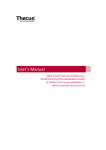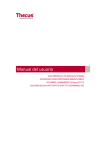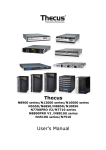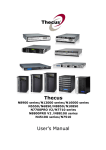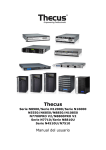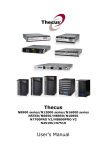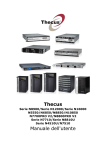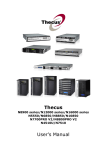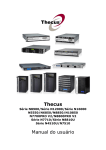Download D-Link DXE-810S System information
Transcript
OS5 X64 FW 2.05.08 [Release Date] Apr 07, 2015 [Applicable Hardware] N16000_N12000_ N16000PRO_N12000PRO_N16000V_N12000V_N8900V_N8900_ N6850_N8850_N10850_ N7710_ N7710-G_N8810_N8810-G N7700PROV2_N8800PROV2 N5810PRO N2800_N4510U_N4510UPRO_N4800_N4800ECO_N5550_N7510_ [Software Upgrade/Downgrade Note] 1. 2. 3. We recommend backup the RAID data before firmware upgrade. There is potential risk of data loss when upgrade the NAS firmware and Thecus is not responsible for any data loss and recovery. Since new version firmware installed, the new software doesn't allow users to downgrade to any previous version firmware. System Configuration Download/Upload does not support different software version. Reminder: After upgrade to latest firmware, download configuration and save separately. [New Features/Changes] 1. 2. 3. 4. 6. 7. 8. Add 4K native (4KN) HDD support. Add disk clone & wipe function. Add D-Link DXE-810S 10 Gigabit Ethernet SFP+ PCI Express Adapter support. Add Kodi support for 16000PRO N12000PRO N16000V N12000V N8900V N8900 N6850 N8850 N10850 N7710 N7710-G N8810 N8810-G & N5810PRO. Add mini UPS & AC Power supply status from SYSTEM INFORMATION -> STATUS. Add VAAI UNMAP support. Add VPN/PPTP client & server support. CVE-2014-0196 9. 10. 11. 12. 13. 14. 15. CVE-2014-4607 CVE-2014-4608 CVE-2014-4611 CVE-2014-6271 CVE-2014-7169 CVE-2014-7186 CVE-2014-7187 5. V1.4.2 1/9 Apr/07/2015 OS5 X64 FW 2.05.08 16. CVE-2014-9295 17. 18. 19. 20. 21. 22. 23. 24. 25. 26. CVE-2015-0235 CVE-2015-0240 CVE-2015-0273 Disabled advance USB COPY function temporary, but USB one button copy function. Improve 3rd party module compatibility. Improve booting process & for huge volume HDD. Improve browser compatibility with IE. Improve compatibility for WD60EFRX. Improve CPU temperature control. Improve Japanese language UI. 27. Improve wording about LAN3~5 items for N5810PRO. 28. Update 2efsprogs to V1.42.12. 29. Update Thecus ID wording. 30. Upgraded Linux kernel to 3.10.66. 31. Upgraded Xfsprogs to v3.2.2. [Bug Fixes] 1. 2. 3. Can’t remove SYSLOG folder in some case. Email notification password can’t accept some symbol in some case. Fix beep warning while USB UPS disconnected. 4. 5. 6. 7. 8. 9. 10. 11. Fix can’t boot into system if USB storage have unknown partition. Fix Samba Recycle Bin can't remove the file from recycle bin. Fix some condition can't access SAMBA share folder via IP or Hostname., Fix some condition can't change jumbo frame from link Aggregation. Fix CUPSD not working in some case. Fix folder limit invalid if restore from snapshot in some case. Fix the folder "0" is not display correctly. UI login function configure page abnormal in some case. [Limitations] 1. There is a capacity limit for different file systems. It means, if more than six 3 TB HDD installed, you may have select suitable file system when creating a RAID volume. File System Capacity Limit EXT3 16 TB EXT4 > 16 TB XFS > 16 TB 2. N12000/N16000 support up to five RAID volumes. For HA RAID volume, just one is allowed. V1.4.2 2/9 Apr/07/2015 OS5 X64 FW 2.05.08 3. RAID volume encryption : AES 256 bits a. NAS admin has to insert an USB flash disk to save encryption key file on it. b. To encrypt an existing RAID is not possible. Please do it while creating a new RAID. c. NAS performance will drop significantly while using encrypted RAID. d. The USB flash disk (key file) should exist whenever the NAS reboots/boots up and doing RAID configuring. e. Encrypted RAID doesn’t support on-line Expansion, just off-line Expansion is doable. f. Encrypted RAID support file system check since V2.03.05. g. If the USB flash disk (key file) lost or key file modified, the RAID data will be INACCESSIBLE FOREVER and no way to recover it. 4. Once the RAID created, there will be about 5% data used by EXT3/EXT4 file system. The capacity stores the journal and inodes; which are necessary to keep RAID data safer. 5. RAID rebuild : in case one HDD failed in RAID 1, 5, 6, 10, 50, and 60 configurations, please hot unplug failed one and hot plug in new one; then RAID rebuilding will automatically start. If the replacement is done after NAS shutdown, administrator has to manually add spare in Admin Web GUI to start the RAID rebuilding. 6. RAID Expansion: When changing the RAID 5 configuration from five smaller disks to five bigger disks, you have to change one disk at a time and then rebuild the RAID. Lastly, utilize the newly added capacity from Space Allocation page. 7. iSCSI Target : the maximum numbers of iSCSI target volumes depend on the physical memory size and also the CPU power of each Thecus NAS. No matter one RAID or multiple RAID volumes exist in a NAS, the maximum limit will be the same. Max. No of iSCSI Targets Model Name 15 N8900V 25 N12000/N12000V/N16000V 50 N8900/N16000 a. For NAS admin without cluster based OS/applications to manage multiple initiators connected to the same iSCSI volume, we highly recommend every iSCSI volume is connected by single iSCSI initiator. However, in case NAS admin has cluster based OS/applications, up to 8 initiators is possible. b. Uncontrolled concurrent access to the same iSCSI target volume may result data corruption or un-predicable results. c. iSCSI target may be disconnected from initiator if other RAID settings on the same target NAS being altered. d. Verified iSCSI initiators: Windows: Microsoft initiator v2.0.4 V1.4.2 3/9 Apr/07/2015 OS5 X64 FW 2.05.08 StarPort initiator 3.5.2 MAC OS: globalSAN iSCSI initiator version 4.1 (279) Linux: open-iscsi 2.0-865 e. There is a system advanced option to choose 4K or 512 bytes block size for iSCSI volume, and the default is 4K bytes. 512 bytes block size may encounter 2TB volume capacity limitation on some initiators running 32bit OS. Nevertheless, 4K block size could slice the iSCSI volume over 2TB, but, there might be compatibility issue. For VMware, we recommend using 512 bytes block size. 8. iSCSI Expansion : there are some limitations applied. a. The maximum iSCSI volume would be 16TB (EXT3/EXT4), and the minimum expansion size is 1GB. b. There is no iSCSI volume size limitation with XFS RAID volume. c. iSCSI service will be stopped till the expansion completes. d. iSCSI expansion just handles the volume size. The partition(s) inside the volume won’t be adjusted. e. iSCSI expansion just support local RAID, does not support add-on RAID by iSCSI stackable. 9. Stackable function : Support of stackable function across Thecus N8900/N12000/N16000 NASes. a. The concurrent connection on target iSCSI volume of Thecus NAS will be limited to 1 if the initiator comes from other Thecus NASes. b. The internal file system format of stackable target is EXT4, and the maximum capacity is 16 TB. 10. iSCSI Thin-Provisioning a. The Thin-Provision capacity has to be determined first. b. Up to five iSCSI Thin-Provision target can be created on the Thin-Provision capacity. c. The total virtual size of iSCSI Thin-Provision targets in a RAID: Thin-Provisioning File System Capacity Limit EXT3 16 TB EXT4 16 TB XFS 64 TB d. The virtual size should be larger than the real capacity and less than 16 TB. e. When determine the virtual size, the minimum increase is 100GB. f. When the total used capacity reaches 90% of real Thin-Provision capacity, NAS will send E-mail notifications out every 10 minutes until the capacity expanded. Also, system log will show capacity warning in admin web interface. The host server won’t receive any notification before the iSCSI Thin-Provision target full. V1.4.2 4/9 Apr/07/2015 OS5 X64 FW 2.05.08 11. iSCSI LUN ID in admin web interface a. The iSCSI LUN ID is between 0 and 254. b. Duplicate ID is not allowed excepting ID 0. c. Mac computer just recognized the first iSCSI volume. 12. Active Directory Support behavior : before AD Sync is pressed, search criteria has to be a fully match string to user account. After AD Sync is pressed, search criteria can be only beginning part of the user account. Only 1000 search results will be displayed. 13. To enable ADS support for Small Business Server 2003, we recommend do not install ISA server. Otherwise, N8900/N12000/N16000 series may fail to join the AD. 14. User Quota : user quota has been added since firmware version 1.00.01. a. Value "0" means "User Quota Disabled" b. A quota setting will be applied across multiple RAID volumes. It means, if you set 10GB quota for user John, he will be having 10GB on every RAID. For a NAS with three RAID volumes, John will have 30GB quota in total. c. "User Quota" is implemented in EXT3, EXT4, and XFS RAID. d. When using "User Quota" in a Master and XFS RAID, disabling quota might not take effective until the NAS reboots. e. When "User Quota" full, the user will have 10% tolerance within 7 days; thus he can do some data moving and deleting temporarily. f. System log and Email Notification will remind the users whose "User Quota" reached the limit at 24:00 everyday. g. The status of "User Quota" across multiple RAID will be displayed on [User and Group Authentication > Quota > Quota Setting] page. h. It may take long time to enable the "User Quota" the 1st time. i. "User Quota" is calculated by UID in the NAS. j. When users put data into a public folder, the used capacity will not be added to quota calculation. Also, data copied through WebDisk will not be calculated either. 15. Some attributes may not be included with files and folders when copying to a USB drive with FAT32 format. 16. If a USB hard drive is connected to NAS formatted as FAT16/32, the following restrictions apply: - Copy file with size greater than or equal to 2 GB to the NAS can not be performed due to FAT file system limitation. - Files created by Mac OS X like DS_Store can not be copied to the FAT16/32 USB drive. 17. NFS share is limited to public folders. In case you enable an NFS share on non-public (ACL) folder, the NFS client could successfully mount it but won’t be able to read/write files. Currently we implemented NFS V3 & V4. V1.4.2 5/9 Apr/07/2015 OS5 X64 FW 2.05.08 18. Reset button : In case the admin password or HTTP port lost, use Reset botton to load factory default please. In that case, user accounts and groups will be erased, but RAID data won’t be affected. 19. HTTP and HTTPS ports should follow the rules given below. - Larger than 1024 - Could not use 3169 - Port 80 (HTTP) and 443 (HTTPS) are allowed 20. Mac OS Limitations a. When using Mac OS X (post 10.2 with AppleTalk) without SMB, do not use Japanese characters in folder or file names to prevent errors accessing the data over a network. b. Mac OS 9 and Mac OS X can not see files on the network with names made up of over 32 characters. c. Mac OS 8.x/9.x only supports local character encoding on file names (without Unicode support). d. Occasionally, when a file is accessed by a Mac OS computer within a shared folder, an information file will be created in the same folder. If the file is then deleted by a Windows OS computer, the original file may no longer be accessible by Mac OS computers. e. The following characters are not allowed to be included in the name used for a file or shared folder when using Mac OS (AppleTalk) devices. ?[]/\=+<>;:”,|* f. Writing a file larger than 2 GB is not allowed by MAC OS-9. 21. NAS needs about 5 minutes to broadcast/register itself to other Mac OS through AppleTalk after booting up and service enabled. 22. WebDisk : Only UTF-8 file name is supported. 23. File size has to be less than 1GB to be uploaded to Thecus NAS from web browsers. FTP software has no such limitation. 24. File names and folder names should not contain more than 250 characters in their entire directory path to prevent errors occur in the file copy operations. 25. The following characters are not allowed to be included in the name used for files or folders on Thecus NAS. /\:*?”<>|[]=+;, 26. File and directory attributes can not be modified by an FTP client when the FTP server of Thecus NAS is enabled. 27. Anonymous FTP user could upload files into public folders but could not delete them. 28. FTP client can list up to 2000 files in a single folder. 29. Thecus NAS could work as a TFTP server since firmware 1.00.01. a. TFTP service folder should be public and without any ACL rule. b. Double byte file name (Chinese, Japanese, Korean, etc) may have problems in V1.4.2 6/9 Apr/07/2015 OS5 X64 FW 2.05.08 case the TFTP client doesn't support UTF8. Anyway we recommend using single byte characters as the file name. c. TFTP service runs at port 69 by default. It is changeable from admin web interface. Please notify possible port conflicts, if any. d. The biggest file size is 4GB while transferring thru TFTP. 30. N8900/N12000/N16000 support specific 10 GbE NIC cards. There will be Additional LAN 1, 2, 3, and 4 to configure the network setting in admin web interface. However, the Link Aggregation functions will just work on original two on-board NIC, WAN/LAN1 and LAN2. 31. File system check page is in English, no multilingual. 32. Disk Power Management : some HDD may not respond to “idle spin down” command, and they won’t get into stand by mode even if the specified idle time had been reached. In addition, N8900/N12000/N16000 do not support SAS HDD spin down at current moment. 33. Disk S.M.A.R.T. Test : N8900/N12000/N16000 do not support Disk S.M.A.R.T. Test on SAS HDD. 34. UPnP function only works on WAN interface. 35. The create date is the same with modify date for every file copied into the NAS. 36. Single file size upper limitation: 2TB for EXT3 file system. 37. Thecus NAS uses the following service ports by default. Services FTP 20/21 SSH 22 DHCP 67/68 HTTP 80 Nfsd 111/2049 Samba 139/445 SNMP 161/162 HTTPS 443 Printer Server 631 Rsync 873 mail server V1.4.2 Default TCP port 995/25 Nsync 2000 Upnp 2689 iSCSI 3260 Mysql 3306 iTunes 3689 DLM2 (amule) 4662 Media 8080 7/9 Apr/07/2015 OS5 X64 FW 2.05.08 WebDAV Apache module DLM2 (bt) Twonky (UI) Services 9800/9802 10080 10000~10200 9000/9001 Default UDP port FTP 20/21 SSH 22 DHCP 67/68 HTTP 80 Nfsd 111/2049 Samba 139/445 SNMP 161/162 HTTPS 443 Printer Server 631 Rsync 873 mail server 995/25 Nsync 2000 Upnp 2689 iSCSI 3260 Mysql 3306 [Known Problems] 1. Using samba protocol in MAC OS will not accept file names with blank characters in tail. 2. IE7 / IE8 will show certification error alert while user access WEB admin UI via HTTPS. [Attention] 1. During firmware upgrade process, it is imperative that user DO NOT turn off the power to Thecus NAS or closes the browser window. This will lead to catastrophic result. If your browser is set to cache the screen, after firmware upgrade has started for 5 minutes, please press CTRL-F5 to reload browser screen from server instead of from browser cache. 2. Thecus strongly recommends NAS admin to backup the RAID data before doing the RAID Migration and Expansion. There is potential risk of permanent data loss when doing Migration/Expansion with disk drives having physical problems, and Thecus is not responsible for any data loss and recovery expense. 3. Enforce to enable the system beeper notification after firmware updated. V1.4.2 8/9 Apr/07/2015 OS5 X64 FW 2.05.08 4. When installing the Windows Wizard program of Thecus NAS on Windows XP Professional SP1 or SP2, Windows Vista, and newer OS, the firewall UDP ports 10000 and 10001 need to be opened. 5. Reset to factory default function automatically resets all the system settings including network settings, administrator password, user groups, language setting, system notification setting, and time zone setting. 6. Users should obey the international RF regulatory rules as they set up the wireless RF channel on the NAS. The RF operating channels for different regions have been specified as following. Thecus has no responsibility for users attempting to violate the international RF regulation. 11 for N. America 14 Japan 13 Europe (ETSI) 2 Spain 4 France V1.4.2 9/9 Apr/07/2015









